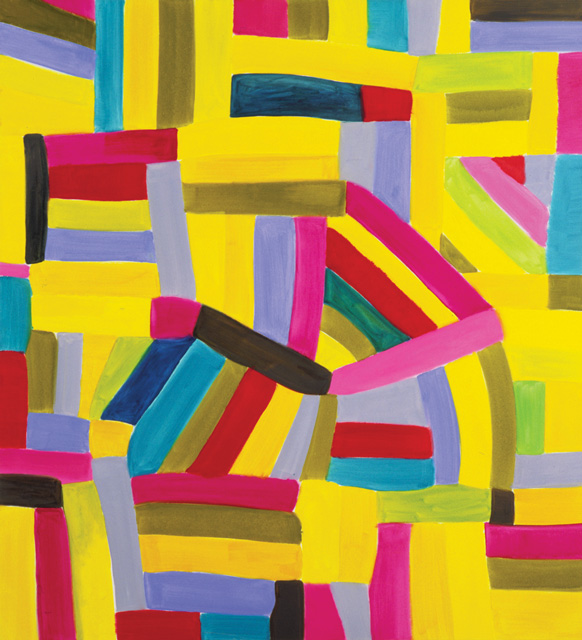


Angela Brennan emerged as one of the most popular Melbourne artists reworking the idea of colour abstraction in the 1990s. Trained in painting at the Royal Melbourne Institute of Technology, her first solo show was held while she was completing a degree in philosophy and fine art at the University of Melbourne. The concepts of analytical philosophy, such as the logic of 'possible worlds', provided a whimsical theoretical basis for her imagery, as well as fuelling the word play of her titles, which are among the wittiest in the business. Brennan was initially grouped with Melbourne artists Elizabeth Newman and Melinda Harper as undertaking a 'gendered re-working of a privileged history of male achievement' in abstraction.1 But Brennan's work is less an earnest deconstruction of the canon than a summoning of buoyant, upbeat essays in colour that reinvest that canon with an infectious good humour. As her former teacher, Geoff Lowe, wrote, 'if Modernism is a man's domain, then Angela Brennan forgives and loves what has gone wrong'.2
Oliver (1996)—the title is a tribute to her first child—is unusual in avoiding the Rothkoesque coloured cloud or 'lozenge in space' format that has become Brennan's trademark. A minority of her works deal with the grid—that icon of twentieth-century abstraction from Mondrian on—by drawing black lines around fields of bright, acidic colour. Oliver, however, is constructed from short coloured blocks, like parquet or cuisenaire rods, laid side to side. There is no blank canvas or empty space: unusually for Brennan in the mid-1990s, the whole surface is intensely charged with colour; the breezy yellows preclude a sense of claustrophobi . The definiteness of Brennan's vertical/horizontal grid is also given a twist, with triangular arrays of blocks and heavy diagonals that make the picture's middle spin like a vortex.
Echoes of tartan plaids or home-made babies quilts sewn from fabric offcuts are doubtless deliberate: domestic culture, being lived by Brennan as a mother as well as successful artist, helps imbue her work with positive, intimate associations. Oliver is a paean or allegorical portrait (and indeed portraiture proper, in a softly coloured, cartoonesque mode, was her alternative art method in the early to mid-1990s). Art historical memories are also activated by Oliver: this kind of composition of parallel colour-patches and radiating forces was explored by Paul Klee in the late 1920s, and even, on grandiose scale, in Kenneth Noland’s hard-edged canvases of the 1960s.
Brennan shares with Klee his sense of whimsy. Oliver was surely not planned in advance: here, as in more recent works in which drips and broad swipes at the canvas abound, improvisation is the key. The artist has said, 'I make it up as I go. Painting gives me access to a world where the imaginary becomes the real and watch what happens next'.3 This very informality, which Stuart Koop has likened to 'a kind of slang: vivid, non-conventional, only vaguely meaningful', opens up an exuberant space for visual enjoyment.4 Brennan's knowing use of diaphanous oil colour abets the pleasures of her inventive compositions . Oliver, like much of her art, refreshingly invites the viewer to enjoy first and leave logic for later.
- Roger Benjamin
Angela Brennan is represented in Australia by Niagara Galleries, Melbourne and Roslyn Oxley9 Gallery, Sydney.